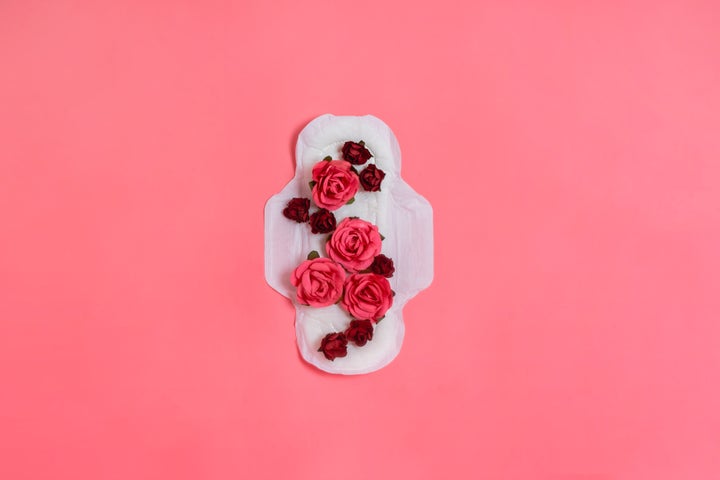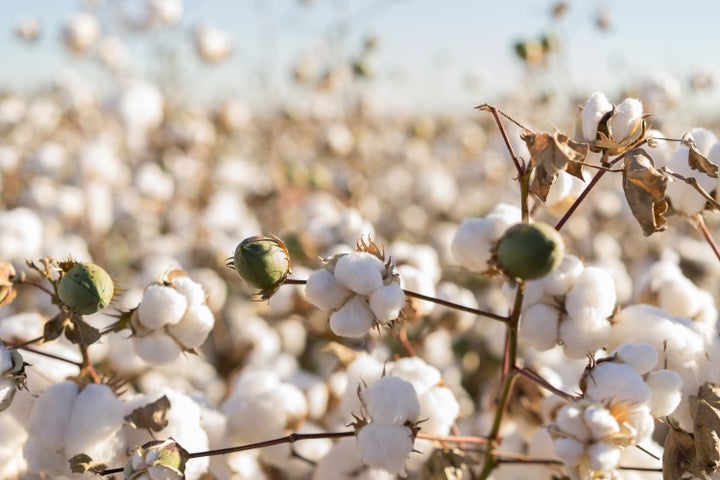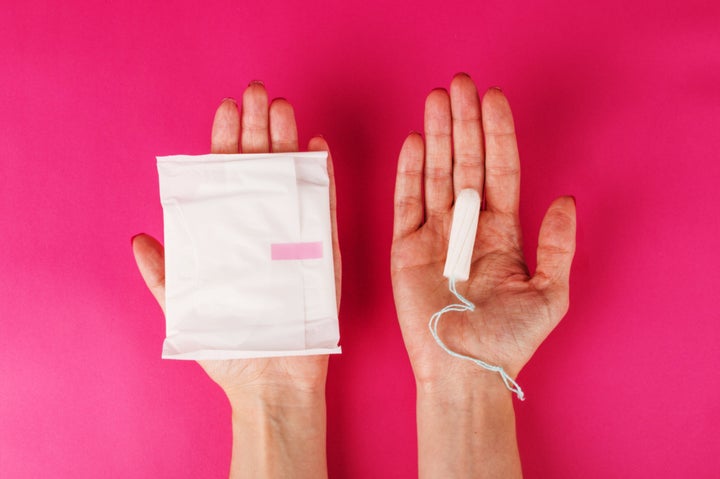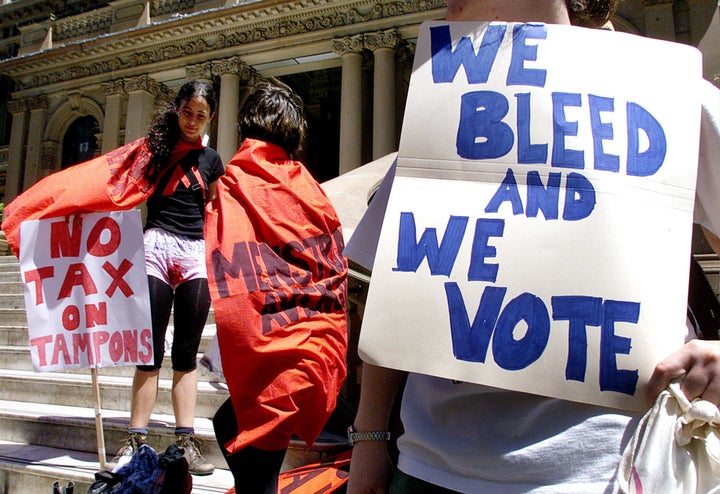
Every month, the ritual for most menstruators in America is the same: Slap on a sanitary napkin or unwrap a tampon, and life goes on, NBD. But it turns out this mindless habit might be wreaking havoc on the planet — and your health, too.
Disposable tampons or pads are the go-to menstrual hygiene product for an overwhelming majority of menstruating Americans, with a reported 98 percent using either or both products every month. The average woman ― and transgender and nonbinary person who menstruates ― will spend approximately 2,280 days on their period and use more than 11,000 tampons or pads over the course of their lifetime. Yet many are unaware of the risky ingredients that these products can contain and what happens to them once they’re tossed out.
Manufacturers aren’t required to disclose ingredients in tampons and pads since they’re considered medical devices by the U.S. Food and Drug Administration, but what we do know about the makeup of these products has compelled health experts and sustainability advocates to raise the alarm.
Most disposable tampons and pads and their packaging contain nonbiodegradable — and potentially toxic — plastic and other synthetic materials like glue (most tampon cords are glued rather than woven in) and petrochemical additives. A package of conventional sanitary pads can contain the equivalent of about four plastic bags.
Most tampons and pads also contain bleached and nonorganic cotton, rayon, wood pulp, or a combination of these materials. Nonorganic cotton and rayon are known to contain pesticides and herbicides including diuron, a chemical that the Environmental Protection Agency has dubbed a “likely” carcinogen, and dioxin, a toxin which the World Health Organization has linked to immune system suppression, reproductive problems and cancer.
The FDA has said that the amount of dioxin an average tampon or pad user absorbs would likely be too negligible to cause harm. But as Dr. Philip Tierno, director of clinical microbiology at the New York University Medical Center, explained to Time magazine, even trace amounts of dioxin are cause for concern as a lifetime of exposure could theoretically increase a person’s risks for disease.
Preliminary research suggests that the plastic in menstrual hygiene products could pose potential health hazards, too.
Given these possible risks, Shradha Shreejaya, a women’s health activist and sustainable menstruation advocate, said consumers have the right to know what their tampons and pads contain.
“Tampons and pads get so close to our body and our sensitive tissue. Think about how much exposure you get to these products over the years. The very minimum that we should demand is to know what goes inside these products,” Shreejaya told HuffPost over Skype from Thailand last week.
The composition of these products also matters from an environmental standpoint, given the staggering amount of waste ― and pollution ― they generate every year.
Worldwide, it’s estimated that over 100 billion menstrual hygiene products are disposed of annually. In North America alone, about 20 billion sanitary napkins, tampons and tampon applicators — which are not recyclable, since they’ve been in contact with human waste — are dumped into landfills yearly.
(Figure out how much waste you’ll personally generate in a lifetime with this menstrual waste calculator.)
Since these items contain plastic, which does not biodegrade, it’ll take at least 500 to 800 years for each pad and tampon to decompose. When incinerated — a common practice in some developing nations — these products release toxic fumes, including carbon dioxide.
Researchers in Stockholm concluded that the plastic back-strip of a sanitary napkin, as well as plastic tampon applicators ― both of which are typically made from low-density polyethylene ― are particularly damaging to the planet. They not only take centuries to break down but also require high amounts of fossil fuel to make.
The manufacturing of disposable menstrual hygiene products (an almost $6 billion industry) generates a total carbon footprint of about 15 million tons of greenhouse gas emissions annually, according to the United Nations Environment Program. That’s the equivalent of burning about 35 million barrels of oil.
Disposable tampons, pads and applicators are also polluting waterways and harming marine wildlife, according to Nick Mallos, director of the Trash Free Seas program at Ocean Conservancy.
Mallos said the nonprofit collected 27,938 used tampons and applicators on beaches around the world in a single day in 2015. A recent report by the European Commission concluded that disposable menstrual products are the fifth most common type of waste washing up on beaches.
“The numbers of these products that are found near and in waterways are pretty astonishing in many parts of the world,” Mallos said.
How, you might be wondering, are pads and tampons ending up en masse in rivers and seas? The problem, Mallos explained, is that many people are flushing tampons ― and pads too ― down the toilet.
Yes, that’s right: Flushing either of these items is a huge no-no.
Flushed tampons, pads, applicators and other items can end up clogging sewer pipes, which can cause untreated wastewater to overflow. This wastewater can eventually make its way to creeks, streams and rivers.
“Not flushing tampons and pads down the toilet is one thing that everyone can do immediately to help enact change.”
Nearly half of all menstruators in the U.K. say they flush their tampons. According to figures published in the Journal of the Institution of Environmental Sciences, about 2.5 million tampons, 1.4 million sanitary napkins and 700,000 panty liners are flushed down the toilet in the U.K. every single day.
“A good rule of thumb is to never throw stuff in the toilet” that’s not the three Ps (paper, poop or pee), Mallos said. “It’s just not a good pathway for proper disposal.”
Even if flushed menstrual products “make it to waste treatment plants, the material that’s captured there has to end up somewhere, and unfortunately that can often end up near waterways too,” Mallos said.
Other than adding to the mammoth problem of ocean plastic pollution, experts say menstrual hygiene products that end up on beaches or waterways pose an additional threat of spreading possible disease and pathogens because of the bodily waste they contain. Communities living near waterways could be at risk, as could marine wildlife that often mistakes plastic products as food.
“Just like in landfills, if a tampon or pad ends up in a waterway, it can just get embedded into the ocean bed or riverbed and it won’t go anywhere for hundreds of years,” Shreejaya said.
Not flushing tampons and pads down the toilet is one thing that everyone can do immediately to help enact change. Here are some other steps you could take to make your period more sustainable (and potentially healthier):
1) Choose reusable menstrual hygiene products like menstrual cups, period underwear and reusable sanitary napkins.

Instead of using disposable pads and tampons that are discarded after just one use, consider using reusable products instead.
The menstrual cup is one product that’s been gaining in popularity. Usually made of medical-grade silicone, menstrual cups are inserted into the vagina, where they collect blood during menstruation.
When inserted correctly, menstrual cups are “more convenient and comfortable than tampons and can be worn for 12 hours,” said Kim Rosas, co-founder of Put A Cup In It, the popular vlog and blog about menstrual cups. “You won’t even feel it’s there.”
Though the history of the menstrual cup in the U.S. dates back to at least the 1930s, Rosas said the product has only recently entered mainstream consciousness.
“We’ve witnessed a huge change from even just a few years ago,” Rosas said. “When I first started using a cup about seven years ago, there was almost no information about the cup online and not many people knew about it. Now, menstrual cup usage is still fairly low but more people at least know that it exists as an option.”
Amanda Hearn, the other co-founder of Put A Cup In It, said the most common reaction she hears from menstrual cup converts is “I wish I had discovered the cup sooner.”
“People don’t realize how irritating and drying tampons are until they use a cup,” she said.
Hearn and Rosas advise first-time cup users to do their research before making a purchase. Cups come in a range of sizes and shapes, so having some understanding of your cervix size can help ensure you find a cup that works best for your body. Put A Cup In It has a nine-question quiz to help menstruators find the right product.
Inserting and removing the cup can also take some getting used to. There is plenty of instructional content online to teach newbies how to use the cup correctly. But if you don’t get it perfect the first time, don’t lose hope!
“Give it a chance. It’s a totally new product, so it might take some time to figure out,” Hearn said. “And don’t be afraid to reach out for help if you need it.”
Menstrual cups may ultimately not be the best option for some menstruators, however. People without access to proper sanitation and those with certain health conditions may not be able to use the cup safely and to best effect.
Other reusable options include period underwear, which is like normal underwear but can absorb flow without leaking if used correctly. Reusable pads made of sustainable materials are also an option. A U.K.-based start-up called DAME unveiled the world’s first reusable tampon applicator last year.
Though reusable products are a bigger financial investment up front compared to disposable menstrual hygiene products, reusables can ― in the long run ― save you thousands of dollars.
A typical menstrual cup can, for instance, be used for up to a decade. Assuming a cup costs about $40, that works out to about 33 cents for every period.
2) When disposables are necessary, choose organic if you can ― and support transparent brands.

There may, of course, be times when you need to use disposable menstrual hygiene products. If those occasions arise, opt for organic products when possible and choose brands that are transparent about the materials they use.
The term “organic” is not always fail-proof, but if buying from a trustworthy source, organic tampons and pads should from cotton that has not been treated with pesticides and other nasty chemicals.
3) Demand that corporations make plastic-free sanitary products.

Sustainability advocate Ella Daish started a viral Change.org petition earlier this year calling on all companies to nix plastic from their menstrual hygiene products.
“With the problems of single-use plastic gaining huge media attention, it is now clear more than ever that it is having an adverse effect on health, wildlife and the environment,” Daish told Glamour magazine in July. “It is crucial that these mass-produced products become plastic-free so that they inflict minimum damage ... whilst the use of plastic is appropriate in certain circumstances, it is certainly not essential for our period products.”
More than 106,000 people have signed the petition thus far.
“By signing the petition, you are calling upon manufacturers to take responsibility for the unnecessary plastic they use whilst raising awareness of this important issue. And the great news is, by going green on your flow, by opting for plastic-free alternatives, you can make real change happen!” Daish told Glamour.
Some of the market’s biggest players are evidently paying attention to the growing consumer demand for more sustainable sanitary products.
Tampon pioneer Tampax unveiled its first-ever menstrual cup in October. A spokeswoman for the company told HelloGiggles at the time that Tampax launched the Tampax Cup to “enter a small, but fast-growing segment to reach, connect, and delight millennials.”
4) Urge lawmakers to pass legislation to make disclosing ingredients mandatory.
A bill calling for the mandatory disclosure of all ingredients in menstrual hygiene products has been languishing in Congress since it was introduced by Rep. Grace Meng (D-N.Y.) in 2017.
The Menstrual Products Right to Know Act “requires menstrual products, such as menstrual cups, menstrual pads, tampons, and therapeutic vaginal douche apparatuses, to include a list of ingredients on the label.”
“We want women to be able to know what chemicals are in these products, which come in direct contact with our bodies,” Meng said last year, according to The New York Times.
Sustainability and health experts say consumers and policymakers need to know what’s in menstrual products so they can make informed decisions about their own personal health, as well as to address the wider issue of how to properly dispose of these items.
“There’s a major lack of accountability among the big manufacturers,” said Shreejaya. “They urgently need to disclose their ingredients and be part of the conversation.”
5) Help make menstruation a bigger public policy priority.

The ultimate goal, Shreejaya said, is to ensure that periods are more sustainable, affordable and equitable for all people who menstruate worldwide. Plastic-free sanitary products, she said, are just a part of the equation.
“We need to tackle this holistically,” Shreejaya said. “And that means menstruation needs to be recognized as a major public health priority. In many countries, there’s a lack of supporting infrastructure like clean toilets and access to water. And when it comes to menstrual hygiene products, we don’t have choice unless we are privileged.”
Globally, periods are keeping girls out of school, and many people who menstruate can’t afford or don’t have access to safe menstrual hygiene products. Lingering cultural stigma about periods has also continued to endanger the health ― and sometimes the lives ― of people who menstruate.
As the New Republic noted in May, stigma could be one reason why menstruators in the U.S. have shied away from using reusable products like the menstrual cup, which can require users to get more intimate with their flow.
“Though a monthly normalcy for around two billion people worldwide, menstruation rarely appears in American popular culture,” the magazine wrote. “When it does, as Lauren Rosewarne demonstrated in her 2012 book Periods in Pop Culture, it’s often treated as a source of embarrassment and shame, whether for comedic or dramatic purposes; sometimes it’s even a source of evil, as in the 1976 horror film Carrie.”
And “the very fact of menstruation seems to appall the president,” New Republic added, referring to Donald Trump’s infamous 2015 jab at journalist Megyn Kelly, who he said had “blood coming out of her wherever.”
“There’s still so much shame and stigma around this topic,” said Shreejaya. “This has got to change.”
This story is part of a series on plastic waste, funded by SC Johnson. All content is editorially independent, with no influence or input from the company.
